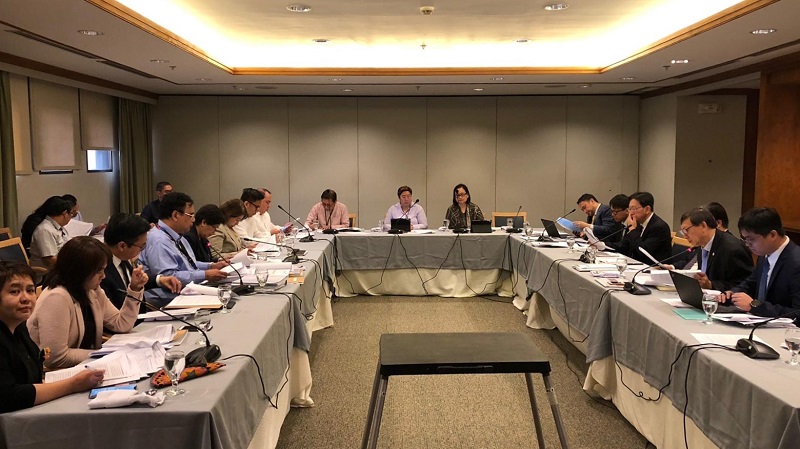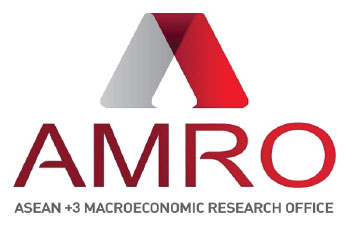 AMRO mission team led by AMRO Lead Economist Dr. Siu Fung Yiu, and Director Mr. Toshinori Doi and Chief Economist Dr. Hoe Ee Khor discusses with the Philippine authorities comprising Bangko Sentral ng Pilipinas Deputy Governor Mr. Francisco Dakila and Assistant Governor Ms. Iluminada Sicat, and Department of Finance Assistant Secretary Ms. Teresa Habitan and their staff.
AMRO mission team led by AMRO Lead Economist Dr. Siu Fung Yiu, and Director Mr. Toshinori Doi and Chief Economist Dr. Hoe Ee Khor discusses with the Philippine authorities comprising Bangko Sentral ng Pilipinas Deputy Governor Mr. Francisco Dakila and Assistant Governor Ms. Iluminada Sicat, and Department of Finance Assistant Secretary Ms. Teresa Habitan and their staff.
SINGAPORE, October 11, 2019 – The Philippine economy is expected to recover from a soft patch in the first half of 2019 as the government ramps up fiscal spending. Macro-economic policies should focus more on supporting growth amid headwinds from a slowing global economy. This is according to the preliminary assessment by the ASEAN+3 Macroeconomic Research Office (AMRO) after its Annual Consultation Visit to the Philippines from September 30 to October 9, 2019.
The mission was led by AMRO Lead Economist Dr. Siu Fung Yiu, and Director Mr. Toshinori Doi and Chief Economist Dr. Hoe Ee Khor participated in key policy meetings. The discussions centered on prospects of the economy, challenges ahead and policy responses.
“We expect the Philippine economy to expand by 6.0 percent in 2019 and 6.4 percent in 2020 respectively, marking a rebound from slowdown caused by the budget delay and spending freeze before the mid-term election.” said Dr. Yiu. “However, heightened uncertainties in the external environment could exert further pressures on the Philippines’ growth and prompt financial market volatilities. Policies should be calibrated to address these challenges.”
Despite a slowdown to 5.5 percent in the first half of 2019, the recent ramp-up in fiscal spending, especially on infrastructure investment, will support stronger economic growth moving forward. Inflation is expected to continue to stay within the 2-4 percent target range for 2019 and 2020, as global oil prices and domestic food prices are likely to be contained and demand pressure to remain subdued.
The current account deficit is likely to widen in the second half of 2019 with the pick-up in investment and growth. Even so, the full-year current account deficit is expected to be lower in 2019 than in 2018.The easing bias of major central banks globally will help sustain capital inflows. The banking system remains sound with stable capitalization and liquidity. The government’s commitment to prudent fiscal discipline will help contain debt accumulation, while fiscal reforms will continue to improve revenue mobilization capacity.
The main short-term risks facing the Philippine economy stem from external sources. The intensifying U.S.-China trade conflicts, major central banks’ policies, and a hard Brexit, have weighed on business sentiments and investment spending. These uncertainties could also exacerbate the current slowing global economy and raise global market volatilities. Domestically, policy restrictions on Philippine Offshore Gaming Operators and the ban on the establishment of new economic zones in the National Capital Region may lead to downward pressures on the property markets. For the longer term, although labor productivity in the Philippines has improved substantially after the global financial crisis, sustaining this trend remains a challenge,
On fiscal policy, concerted efforts are needed to make up for the fiscal underspending in the first half of this year and to avoid any budget delay in 2020. The government’s “catch-up plan” has led to a pickup in fiscal spending recently, however, should the fiscal spending miss the target, some budget items could be carried over into 2020.
Monetary policy should be on an easing bias to support the economy if inflationary pressure remains subdued and growth turns out to be weaker than expected. The reduction of 75 basis points in policy rate and the staggered 300 basis points cuts in reserve requirements since May 2019 have led to a substantial easing in monetary conditions, providing support for the recovery in economic activities in the months ahead.
Macro-financial surveillance should be strengthened and potential risks from a downward adjustment in the property market should be closely monitored. The authorities should continue to enhance the comprehensiveness, coverage and timeliness of financial surveillance database, particularly those of large conglomerates.
Despite the challenging external environment, the current wave of reconfiguration of global supply chains also opens a window of opportunities. The Philippine authorities should continue to push forward key reforms and ensure effective implementation of ongoing reforms to lay a good foundation for long-term sustainable development. The authorities’ continued efforts to improve the doing business environment are also welcome.
The mission would like to express its appreciation to the Philippine authorities and other counterparts for their assistance and warm hospitality. The consultation visit has deepened AMRO’s understanding of the country’s current macroeconomic and financial situations as well as ongoing efforts to address the risks, vulnerabilities and challenges confronting the economy.
—
About AMRO:
The ASEAN+3 Macroeconomic Research Office (AMRO) is an international organization established to contribute towards securing macroeconomic and financial stability of the ASEAN+3 region, which includes 10 members of the Association of Southeast Asian Nations (ASEAN) and China; Hong Kong, China; Japan; and Korea. AMRO’s mandate is to conduct macroeconomic surveillance, support the implementation of the regional financial arrangement, the Chiang Mai Initiative Multilateralisation (CMIM), and provide technical assistance to the members.
